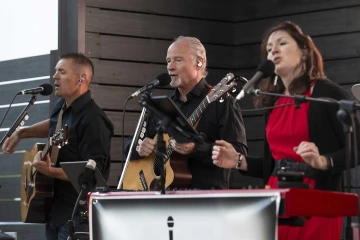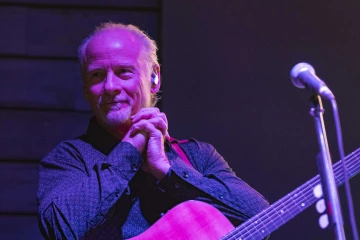John Woolf is a collaborator at work and in the music studio
College of Health Sciences assistant professor relishes the opportunity to create new Doctor of Physical Therapy program.

John Woolf, PT, PhD, ATC, second from left, performs regular gigs around Tucson, playing covers and original songs.
Photo by Noelle Haro-Gomez, U of A Health Sciences Office of Communications
This is a season of firsts for John Woolf, PT, ATC, PhD.
An assistant professor in the University of Arizona College of Health Sciences’ new Doctor of Physical Therapy program, Woolf is part of the team building the curriculum and a culture of collaboration.

John Woolf, PT, PhD, ATC, is a former U of A head athletic trainer and is excited to be part of the new U of A College of Health Sciences Doctor of Physical Therapy Program.
Photo by Kris Hanning, U of A Health Sciences Office of Communications
“It’s exciting to be on the ground floor of a program that has a lot to offer the health care professions,” Woolf said.
In fact, it’s a pretty exciting time for Woolf personally as well as professionally. His band After 7 just released its first album.
The process of working together to create original songs, Woolf said, is fairly similar to building a new college program.
“With a song, you start with the basics – some lyrics and a melody,” Woolf said. “From that starting point, you get together with your bandmates and accelerate the creative process. Each person adds an instrument and a harmony. As band members contribute their expertise and creativity, the sound gets fuller, with more texture, and becomes a more interesting song.
“Creating a new PT program is similar in many ways. We started with the basics required of any accredited program, and, as a team, we have been contributing from unique backgrounds and layering innovative methods into the curriculum to better engage students. Super fun!”
Changing course
As a high school fullback in Yuma, Woolf knew exactly where he was headed: college on a football scholarship.
He was leaning toward studying engineering at the U.S. Air Force Academy until a fateful tackle during the last practice of his senior season changed those plans.
“I was carrying the ball through the line, got tackled and snap,” said Woolf. “I picked up my leg, but my foot stayed on the ground.”
A broken fibula meant the end of a football career but a new beginning for Woolf. He called it destiny.
“I had to work with a physical therapist, and I got interested in becoming one because of that,” said Woolf. “For many, an injury or an affliction is kind of a devastating experience. A good physical therapist can meet that person where they are and establish a therapeutic alliance, successfully guide that person to a place of more wholeness.”
That’s the kind of treatment Woolf received as a teenager. It’s also what he has practiced throughout his career and what he will teach others to do when the first class of physical therapy students is expected to start next fall.
A long time coming
After making the decision to study physical therapy, attending Northern Arizona University was a no-brainer, since NAU had the only physical therapy program in the state. The Arizona Board of Regents approved the U of A Health Sciences’ developing Doctor of Physical Therapy program in 2022, paving the way for the much-needed program. The field is expected to grow 14%, much faster than average, through 2033 as the population of the United States ages, according to the U.S. Bureau of Labor Statistics.

John Woolf’s bandmades include his wife Chris and daughter Natalie along with friends he made as part of the U of A’s St. Thomas More Catholic Newman Center’s 7 p.m. Sunday choir in the 1990s.
Photo by Noelle Haro-Gomez, U of A Health Sciences Office of Communications
“I am excited there’s now a PT program in Southern Arizona at a state school aligning with the values and the mission of the University of Arizona, which is important,” Woolf said.
The faculty is working on accreditation now as applications roll in. The first class is expected to train about 50 future physical therapists. The innovative, fully in-person program will be taught in a block format with clinical experiences comprising 36 weeks of the three-year curriculum, said Chris Childers, PT, PhD, an associate professor and director of the physical therapy program.
Just as a catchy song is the perfect blend of lyrics and melody, the program combines essential skills training along with an awareness of the importance of empathy and a therapeutic relationship.
Woolf, who has a doctorate in performance psychology, said the program will have a strong emphasis on the “therapy” part of physical therapy.
“Health care right now is struggling to get footing on the humanistic part of being a health care provider,” said Woolf, whose research involves examining traits that help physical therapists connect with their clients. “Our curriculum and strategy for engaging students is going to be one that emphasizes the relationships between patients and providers.
“You’re not treating just elbows, shoulders and knees. You’re treating people. That’s a complex interaction that requires the application of complex skills, including communication and relationship skills. Students will not only be drilled on all the technical aspects of the profession, but will also learn to appreciate and deliver on what the patient often values most are the relational components.”
That's an area where Woolf excels, Childers said.
“Dr. Woolf is very thorough and knowledgeable both in the discipline of PT and in organizational development, teamwork and the psychology of the profession, and he’s great at establishing therapeutic relationships with the clients,” she said. “He brings a great strength to the faculty, grounding us for details but with a strong sense of humor.”

Creating a song isn’t unlike creating a new physical therapy program, John Woolf says – both are a collaborative effort with each person adding expertise and creativity.
Photo by Noelle Haro-Gomez, U of A Health Sciences Office of Communications
Collaboration is key
Woolf, who at one time owned several clinics across Tucson, honed his skills in the U of A athletic department’s training room as a rehab coordinator. The avid cyclist and father of two worked his way up to head athletic trainer in the 1990s, the era of Desert Swarm and the 1997 NCAA basketball championship team. Woolf was a fixture on the sidelines of Arizona Stadium and helped lead a dedicated team of medical professionals. The role was a front-row seat to observe how the body works, recovers from injury and ultimately gets back to performing at a high level. He enjoyed the chance to partner with and help elite athletes be their best. He is applying this training and experience in his current role working with dancers and musicians in the U of A’s College of Fine Arts.
“When I look back, the most notable influence in working in that environment is the universal commitment to excellence,” Woolf said. “I worked with student athletes and sports teams and medical professionals who were continually striving to get better. I watched how some great coaches were able to, not just train athletes to perform at the highest level, but also to inspire them to be great people as a part of the UA community. These experiences have certainly influenced the way in which I am working with an incredible faculty who have a similar commitment to excellence. We all recognize the importance of not only training the skills necessary to be a great physical therapist, but also share the commitment to guide students in a process of professional formation so they can successfully serve their communities.”

